The spatial distribution of kernel density of secondary topics in the Beijing-Tianjin-Hebei, Yangtze River Delta, Pearl River Delta, Chengdu-Chongqing, and Hubei Province are shown in Figures 5-9. And different topics have significant differences within different regions.
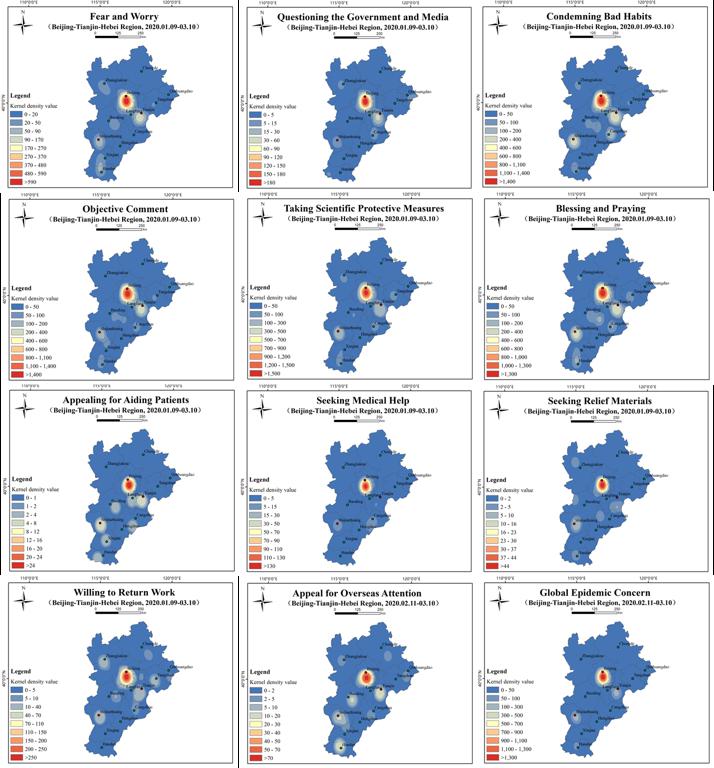
The microblogs responses in the Beijing-Tianjin-Hebei region highlighted Beijing as the core high-value area, followed by Tianjin, Shijiazhuang, Baoding and Handan, indicating the large number of media and high public responses in Beijing, which is also resulted from the low number of confirmed outbreaks in other regions outside Beijing. As of March 10, the cumulative confirmed cases in Tianjin and Shijiazhuang were 136 and 29, accounting for only 0.17% and 0.03% respectively of the total cases in China (the total confirmed case was 80778 in China).
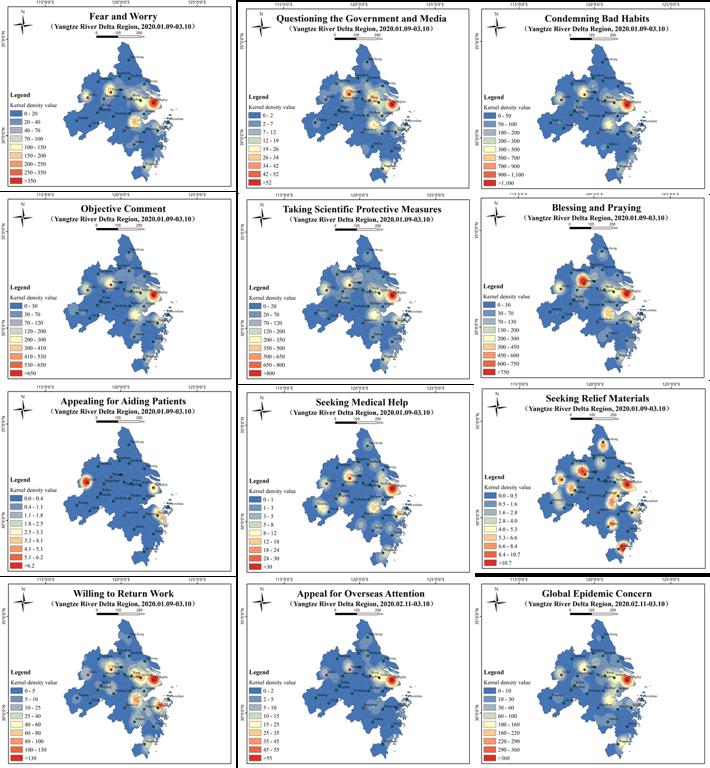
The distribution of topics in the Yangtze River Delta region mainly focuses on Shanghai. “Objective comment”, “Taking scientific protective measures”, “Appeal for overseas attention”, “Condemning bad habits” and “Global epidemic concern” are concentrated in Shanghai. “Fear and worry”, “Questioning the government and media” and “Seeking medical help” take Shanghai as the highest point, Nanjing and Hangzhou as the second points, and Wuxi also shows high aggregation points in some categories. The “Blessing and praying” is prominent in Nanjing and Shanghai. “Appealing for aiding patients” has formed a relatively independent high concentration point in Hefei, which is slightly reflected in Ningbo and Shanghai. "Seeking relief materials" takes Shanghai, Nanjing and Wenzhou as the highest gathering points, followed by Yancheng, Hefei, Wuhu, Hangzhou, Jiaxing, Ningbo and Jinhua. "Willing to return work" takes Shanghai as the hottest area, and the followed hot areas are Ningbo, Hangzhou, Suzhou, Wuxi and Nanjing in that order. “Global epidemic concern” is centred on Shanghai, supplemented by Suzhou, Wuxi, Changzhou and other cities.
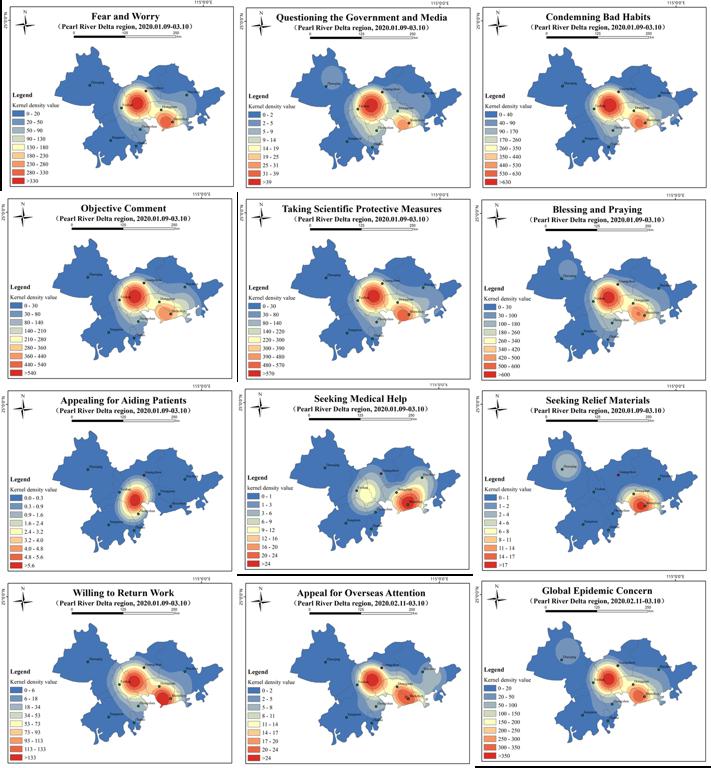
In the Pearl River Delta region, "Fear and worry", "Questioning the government and media", "Condemning bad habits", "Objective comment", "Taking scientific protective measures", "Blessing and praying", "Willing to return work", "Appeal for overseas attention" have similar spatial distribution characteristics, which are prominent in the two first-tier cities of Guangzhou and Shenzhen, supplemented by relatively high-value areas such as Foshan and Dongguan. "Appealing for aiding patients" is concentrated on the junction of Guangzhou, Foshan and Zhongshan, and spreads to the surroundings and the whole is distributed in a circular shape. “Seeking medical help” takes Shenzhen as a prominent high-value area and spreads to the north and east, the second highest point is located in Foshan, with a two-core distribution as a whole. "Seeking relief materials" takes Shenzhen as the core, spreads in a fan shape to the north, radiating to Dongguan and Huizhou, and Zhaoqing is an independent high-value area.
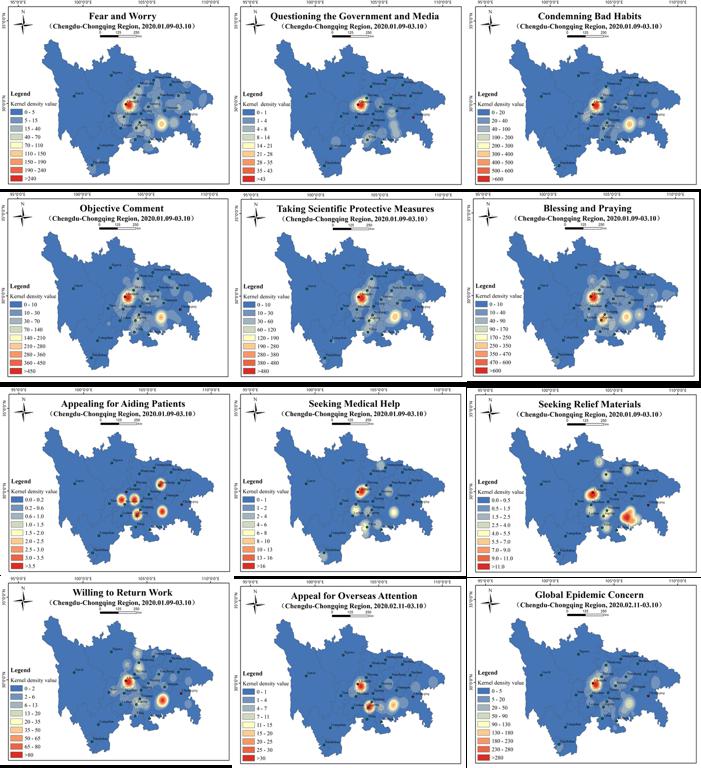
The distribution of topics in Chengdu-Chongqing is mainly concentrated on Chengdu and Chongqing. "Fear and worry", "Condemning bad habits", "Objective comment" and "Taking scientific protective measures" are centrally distributed taking Chengdu as the core, with the second highest point in Chongqing. "Global epidemic concern" and "Questioning the government and media" are concentrated on Chengdu. The "Blessing and praying" are distributed centrally with Chengdu as the core, with Chongqing and the junction of Zigong and Neijiang as the second highest point. "Appealing for aiding patients" takes the junction of Chengdu-Meishan-Ya'an, Chengdu-Meishan-Ziyang, and Zigong-Neijiang as the high value distribution areas, and Chongqing and Nanchong are relatively independent high value distribution areas. "Seeking medical help" is prominent in Chengdu. "Seeking relief materials" and "Willing to return work" take Chengdu and Chongqing as high-value distribution areas. "Appeal for overseas attention " takes Chengdu, and the junction of Zigong-Neijiang as the high value distribution area, and the second highest point is located in Chongqing.
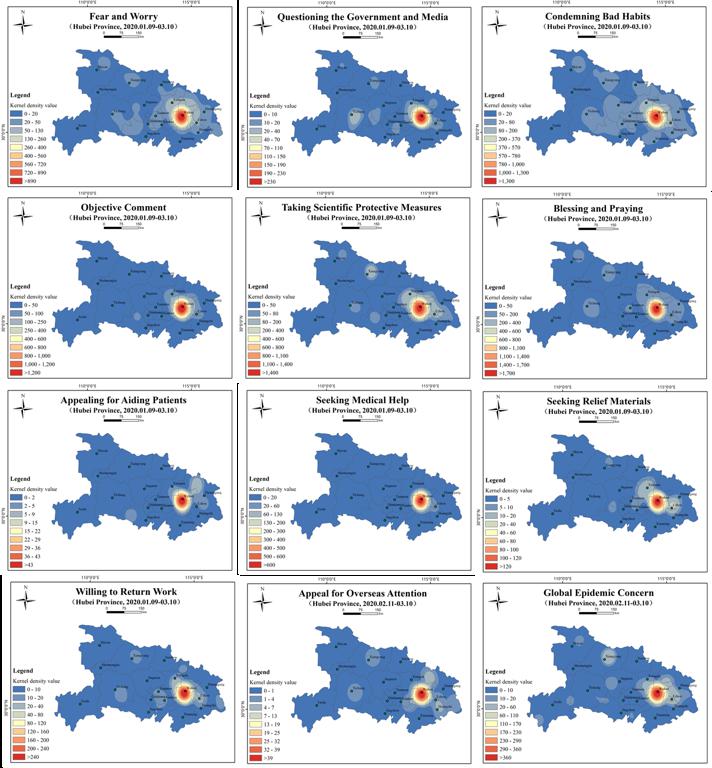
As the most severe epidemic area, the analysis of public opinion of Wuhan, Hubei has important guiding value for the proposal of epidemic prevention. The spatial distribution of the topics has similar characteristics, that is, Wuhan is the core and radiates to the surroundings. "Fear and worry" and "Condemning bad habits" take Wuhan as a prominent high-value area, and radiate to a large range of neighboring cities, and extend to the north more significantly. The "Seeking medical help" is just prominently displayed in Wuhan, and the spread to the surrounding area is relatively small. The remaining 9 topics are centered on Wuhan and distributed to a small range of neighboring cities such as Xiaogan, Huanggang and Ezhou, supplemented by independent high-value areas such as Xiangyang, Yichang, Shiyan and Jingzhou.
